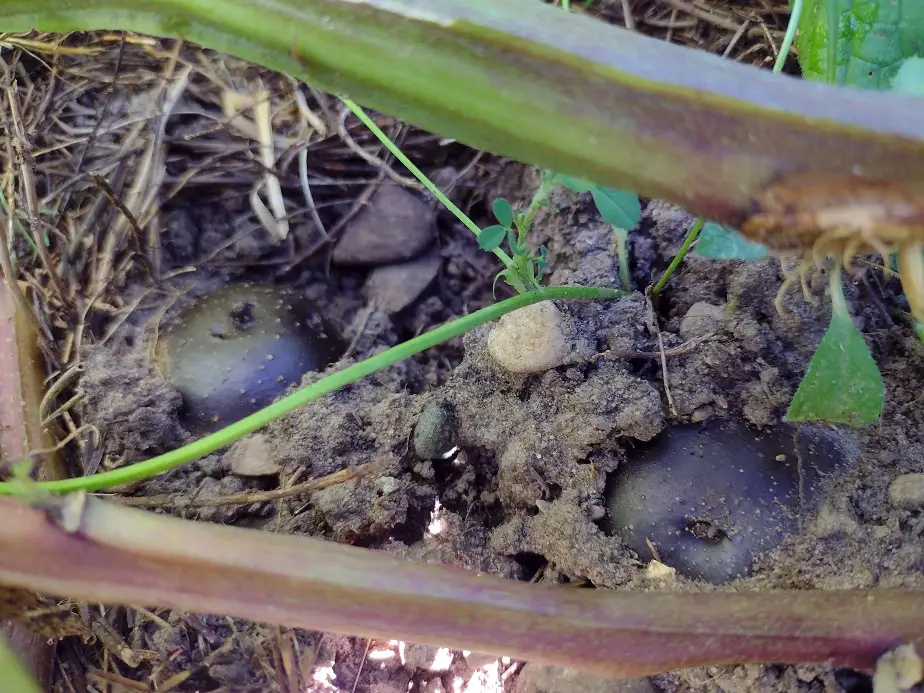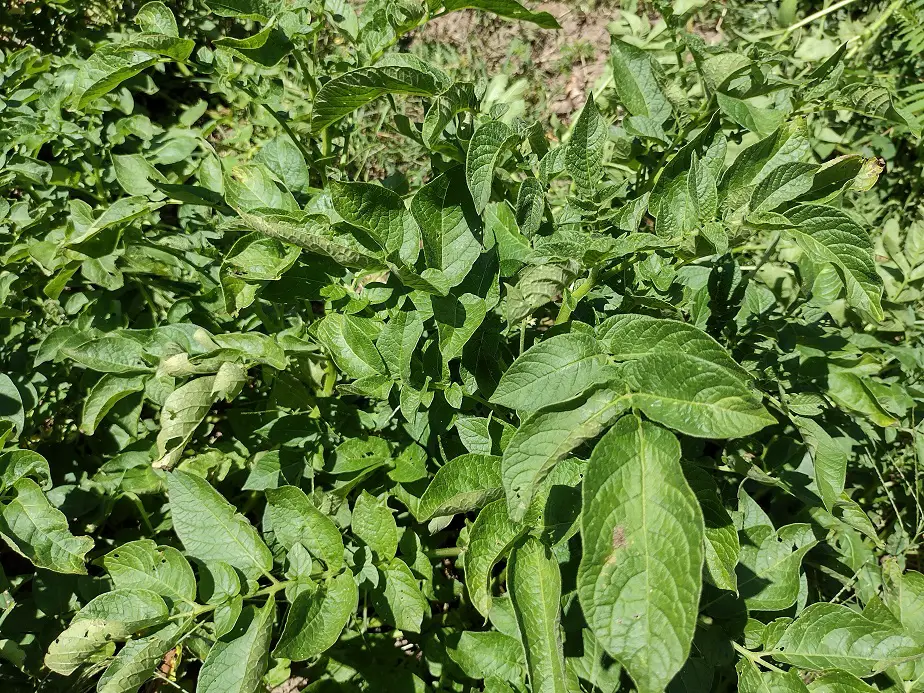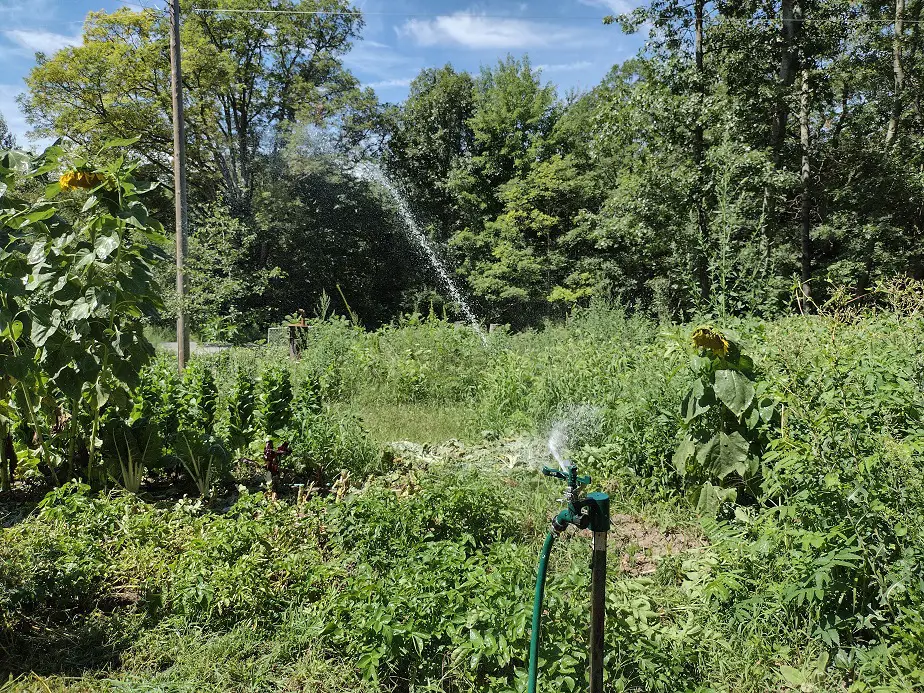Potatoes are awesome! I’m in the middle of harvesting summer potatoes and plan on a fall planting to harvest next spring.
Potatoes don’t need a lot of water. They require an inch a week, about a gallon per plant, in average tilled soil during the summer. In soil rich in organic matter, they need less water but in poor soil, potatoes may need 2 or more inches of water a week to yield well.
Water is key in getting a decent yield from your potato plants. Too little and they won’t grow. Too much and they may grow slowly, or rot in the ground.
How Much Water do Potatoes Need?
Potatoes need about as much water as any other vegetable crop. Often, they need very little in the spring and moderate water in the hot summer months. Once the soil dries out a few inches deep, Potatoes should get 1 or 2 inches of water. That can last a week or two, or less, depending on the weather and soil.
Durring Michigan summers (between 80 and 90 degrees and humid), I may water them once a week, and give them a good inch at a time. That lasts all week in the hottest dry spells, these days. But, that wasn’t always the case. My potatoes used to need at least twice as much water if not three times as much.
In very sandy soil like my parents have, they may need an inch of water 3 times a week in the summer. In low organic matter, clay-sand soil that I started with, they needed a good inch twice a week in the summer heat to keep from drying out.
Bad soil uses a lot more water because it loses a lot more water. Clay in soil holds some water, but it’s organic matter that really soaks up water. If your soil holds good water, then it needs watering a lot less frequently. Organic
The organic matter of the soil holds on to water, keeping it from evaporating or ebbing away through the soil. That way, it remains available for the plant like a water-based savings account. Basically, all the problems of growing food can be greatly reduced by building up the soil’s organic matter.
The soil is what makes the difference. I have said in classes that soil quality is everything, and I stand by that. My soil used to be hard as a rock and hardly grew grass. Now, it’s some of the most productive and healthy dirt I’ve ever seen.

Can You Give Potatoes too much Water?
Potato plants can be overwatered, leading to root damage, plant die-off, and potato rot. Waterlogged soil for extended periods can kill the entire plant. Allow your soil to dry out a bit between waterings, and be sure your soil is well-drained and aerated.
The Irish Potato Famine was caused in part, by too much water. Heavy rains damaged potato crops, causing sickly plants to be overcome with rot and disease. I see some of this to some extent every spring. I plant potatoes early in the spring. The melting snow and spring rains take a toll.
I lose 10 to 20 percent of my early planted (still snow in places) potatoes due to waterlogged soil choking off the planted tubers. They rot, sometimes before they even start growing. But, in that instance, it’s worth it to get an extra-early harvest.
I will be very careful not to overwater my potatoes during the normal season. If the soil isn’t dry, they don’t need water. When the dirt starts getting dry and kicking some dust, it’s time for a good watering. I use impact sprinklers, the kind that mounts on a t-post. That’s the only irrigation I use in the whole garden.
For me, it takes about an hour to get an inch of water from the sprinklers, depending on how many are running and how wide of an area they are watering. Running one or two sprinklers and doing a half-circle pattern, an hour is about an inch of water for my garden. I have pretty good water pressure.

Do Potatoes Need Irrigation?
Potatoes usually need irrigation to have a good yield. Areas with 30 or more inches average rainfall can grow potatoes without irrigation but at 50 percent lower yields. Without irrigation, a bad year may yield a 10 to 30 percent harvest. Consider your average rainfall to determine of you need to irrigate.
Potatoes are watered commercially with huge overhead impact sprinklers. Smaller growers, like me, usually use regular garden-sized impact sprinklers. I do know people who grow the old-fashioned way, relying on the rain, but that hardly ever reaches a full-yield harvest.
Depending on the variety, plants producing medium to large potatoes usually yield between 4 and 6 pounds* at best. I grew 800 potato plants this year. Without watering, I expected an 800-1600 pound harvest. With watering, I expect a 3,000-4,000 pound harvest. That’s well worth it to me.
*An article I wrote has a chart of goal yields for popular potato varieties. Here’s a link to it.
Whether you are growing for your table, to sell at market, or both like us, It’s often worth it to look into low-cost irrigation. I had the well put in on our property several years ago, and only needed a hydrant, some hose, and sprinklers.
That cost me about $450, and I more than made it up in produce halfway through the first year. I’m glad I finally did because I can finally grow enough for my family and for the Howard City Farmer’s Market.
Related articles:

